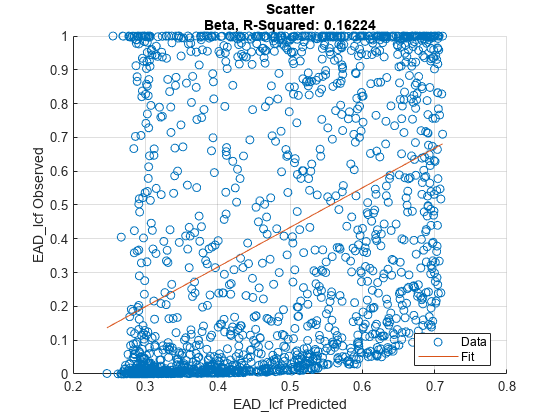Beta
Description
Create and analyze a Beta model object to calculate the
exposure at default (EAD) using this workflow:
Use
fitEADModelto create aBetamodel object.Use
predictto predict the EAD.Use
modelDiscriminationto return AUROC and ROC data. You can plot the results usingmodelDiscriminationPlot.Use
modelCalibrationto return the R-squared, RMSE, correlation, and sample mean error of predicted and observed EAD data. You can plot the results usingmodelCalibrationPlot.
Creation
Description
BetaEADModel = fitEADModel(___,Name=Value)BetaEADModel =
fitEADModel(EADData,ModelType,PredictorVars={'UtilizationRate','Age','Marriage'},ConversionMeasure="lcf",DrawnVar='Drawn',LimitVar='Limit',ResponseVar='EAD')
creates an BetaEADModel object using a
Beta model type.
Input Arguments
Name-Value Arguments
Properties
Object Functions
predict | Predict exposure at default |
modelDiscrimination | Compute AUROC and ROC data |
modelDiscriminationPlot | Plot ROC curve |
modelCalibration | Compute R-square, RMSE, correlation, and sample mean error of predicted and observed EADs |
modelCalibrationPlot | Scatter plot of predicted and observed EADs |
Examples
More About
References
[1] Baesens, Bart, Daniel Roesch, and Harald Scheule. Credit Risk Analytics: Measurement Techniques, Applications, and Examples in SAS. Wiley, 2016.
[2] Bellini, Tiziano. IFRS 9 and CECL Credit Risk Modelling and Validation: A Practical Guide with Examples Worked in R and SAS. San Diego, CA: Elsevier, 2019.
[3] Brown, Iain. Developing Credit Risk Models Using SAS Enterprise Miner and SAS/STAT: Theory and Applications. SAS Institute, 2014.
[4] Roesch, Daniel and Harald Scheule. Deep Credit Risk. Independently published, 2020.






